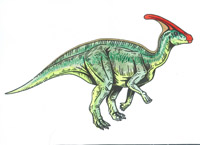Disambiguation Links – Parasaurolophus walkeri (S/F-Ride) / Parasaurolophus walkeri (S/F) / Parasaurolophus walkeri (JN) / Parasaurolophus walkeri (T/C)
“Similar Saurolophus” found in Western North America and described by Parks in 1922. Parasaurolophus lived in the late Cretaceous about 76-65 Million years ago. It was 10.05 meters (33 ft.) in length, 4 meters (13 ft.) in height and weighed 4 tons.
Parasaurolophus were seen on Isla Sorna when paleontologist Dr. Richard Levine was observing the herd of animals from across the river in the high hide. The Parasaurolophus had formed a symbiotic relationship with the Apatosaurus, the two using the combination of their primary senses to make up for each other species’ weaknesses. The Parasaurolophus acted as the “eyes” of the group, spotting predators and alerting the Apatosaurus, who then protected the Parasaurolophus herd from predators. While observing them from the high hide, Dr. Levine attempted imitating their trumpeting calls, which coincided with the Parasaurolphus suddenly forming a marching line. Believing he had inadvertently disrupted them, Levine followed the linear travelling herd to a jungle clearing where he discovered they were actually communal latrine animals, and had travelling in the formation to a designated location to relieve themselves. Once they had finished, Levine noted that the Parasaurolophus would drink from their own urine puddles to reabsorb lost nutrients in the waste such as sodium.


